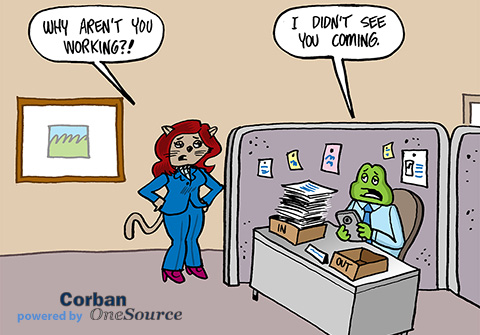Signs of quiet quitting which is a phenomenon that has been around for some time but has only recently begun to be discussed more openly. It’s a type of disengagement that often manifests itself in employees who are doing the absolute bare minimum at work without getting fired to appear as if they are working. It can occur for a variety of reasons:
- Boredom
- Personal issues
- Lacking direction
- Lack of motivation
- Feeling overburdened or unappreciated
See if you can find the quiet quitting meme that corresponds to one of the bullet points above.



Whatever the cause as illustrated in a Quiet Quitting Meme, the consequences of quiet quitting can be devastating for teams and organizations. That’s why it’s important to be able to recognize the signs of quiet quitting and know what to do if you find yourself in a situation with one or more employees exhibiting these behaviors.
Recognizing the Signs of Quiet Quitting
Identifying the signs of this behavior isn’t always easy, but some common indicators can help you spot it. From repeated tardiness and absenteeism to a sudden drop in productivity, these signs can help you determine if an employee is exhibiting quiet quitting behaviors:
Missing deadlines: When employees regularly miss deadlines and turn in tasks late, it could be a sign that they are no longer invested in the job. This can be a major disruption to team productivity and should be addressed immediately.
Avoiding conversations or meetings: If an employee avoids any type of conversation or meeting with you often, it may indicate that they feel disengaged. Whether this is in-person or remote meetings, this disengagement from team activities could be a sign.
Poor quality of work: If an employee’s work quality has decreased suddenly, it might be a sign that they are no longer committed to producing high-quality outputs, but are simply putting in the smallest amount of effort possible. This can be a sign they are subtly quitting and hoping that no one notices, or are no longer motivated to do the work.
Lack of communication: If an employee has stopped communicating with you or other members of the team, this could indicate that they are quiet quitting. This could be especially true if they used to be an active participant in conversations and meetings before.
Lack of follow-through: If an employee begins to forget details or fails to complete tasks that were once completed easily, this could be a warning sign of quiet quitting behavior. This can lead to unmet expectations and put the team’s overall success at risk.
Combating Quiet Quitting
Once you’ve identified an employee exhibiting quiet quitting behaviors, it’s important to take action quickly to reduce their likelihood of completely disengaging from the job. Here are some tips for preventing quiet quitters:
Encourage Employee Engagement: The first step to combating quiet quitting is to encourage employee engagement. Make sure that each team member feels appreciated, heard, and motivated. Encourage open communication between everyone on the team, and provide clear goals and direction for what success looks like. This will help create a sense of purpose in their work and make them feel valued by their peers. For example, you can use rewards and incentives to recognize their efforts, or simply give them positive feedback for a job well done.
Provide Supportive Resources: Make sure that employees have access to the tools and resources they need to succeed. This could include additional training or mentorship from more experienced team members. You want to be aware of the needs of each team member and do whatever you can to support their development. Be it providing resources that will improve their daily workflow or guidance through projects, this will help create an environment where employees are empowered to do their best work.
Set Clear Expectations: It’s important to make sure that expectations are clear from the start. Set clear guidelines and deadlines for tasks, provide regular feedback on performance, and be open to changes in workflow if needed. This will help ensure that everyone is held accountable for their work and that the team is working together to meet the goals at hand.
Leverage HR Outsourcing: HR outsourcing can be a great way to combat quiet quitting. By enlisting the help of an external HR firm, you can ensure that all employees have access to the resources they need to perform their job effectively. They will also be able to provide guidance and support on a variety of issues, from onboarding new employees to dealing with performance issues. This can take the burden off of the internal HR team and free up time for other essential tasks.
Quiet quitting is a severe issue that can have detrimental effects on an organization if not addressed quickly. By recognizing the signs of quiet quitting and taking proactive steps to combat it, you can ensure that employees remain engaged with their job and continue to contribute to the success of your organization. HR outsourcing can be a great resource for dealing with these issues, as they have the expertise needed to provide guidance and support on a variety of topics while controlling. We even provided a fun Quiet Quitting Meme to illustrate a few of the signs. Corban OneSource has experience helping companies with 75 to 6,000 employees manage their outsourced HR needs, so contact us today or view our complete HR services here.

